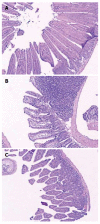Carbon liberated from CO-releasing molecules attenuates leukocyte infiltration in the small intestine of thermally injured mice
- PMID: 18069757
- PMCID: PMC4171227
- DOI: 10.3748/wjg.v13.i46.6183
Carbon liberated from CO-releasing molecules attenuates leukocyte infiltration in the small intestine of thermally injured mice
Abstract
Aim: To determine whether Carbon (CO) liberated from CO-releasing molecules attenuates leukocyte infiltration in the small intestine of thermally injured mice.
Methods: Thirty-six mice were assigned to four groups. Mice in the sham group (n = 9) were underwent to sham thermal injury; mice in the burn group (n = 9) received 15% total body surface area full-thickness thermal injury; mice in the burn + CORM-2 group (n = 9) were underwent to the same thermal injury with immediate administration of tricarbonyldichlororuthenium (II) dimer CORM-2 (8 mg/kg, i.v.); and mice in the burn+DMSO group (n = 9) were underwent to the same thermal injury with immediate administration of 160 muL bolus injection of 0.5% DMSO/saline. Histological alterations and granulocyte infiltration of the small intestine were assessed. Polymorphonuclear neutrophil (PMN) accumulation (myeloperoxidase assay) was assessed in mice mid-ileum. Activation of nuclear factor (NF)-kappa B, expression levels of intercellular adhesion molecule-1 (ICAM-1) and inducible heme oxygenase in mid-ileum were assessed.
Results: Treatment of thermally injured mice with CORM-2 attenuated PMN accumulation and prevented activation of NF-kappa B in the small intestine. This was accompanied by a decrease in the expression of ICAM-1. In parallel, burn-induced granulocyte infiltration in mid-ileum was markedly decreased in the burn mice treated with CORM-2.
Conclusion: CORM-released CO attenuates leukocyte infiltration in the small intestine of thermally injured mice by interfering with NF-kappa B activation and protein expression of ICAM-1, and therefore suppressing the pro-adhesive phenotype of endothelial cells.
Figures





Similar articles
-
Role of CO-releasing molecules liberated CO in attenuating leukocytes sequestration and inflammatory responses in the lung of thermally injured mice.J Surg Res. 2007 May 1;139(1):128-35. doi: 10.1016/j.jss.2006.08.032. Epub 2007 Feb 9. J Surg Res. 2007. PMID: 17292406
-
Attenuation of leukocytes sequestration by carbon monoxide-releasing molecules: liberated carbon monoxide in the liver of thermally injured mice.J Burn Care Res. 2007 Jan-Feb;28(1):173-81. doi: 10.1097/BCR.0b013E31802CA491. J Burn Care Res. 2007. PMID: 17211222
-
[Molecular mechanism of inhibition of early pulmonary injury and inflammatory response by exogenous carbon monoxide: experiment with mice].Zhonghua Yi Xue Za Zhi. 2007 Nov 27;87(44):3148-51. Zhonghua Yi Xue Za Zhi. 2007. PMID: 18269877 Chinese.
-
CO-releasing molecules (CORM-2)-liberated CO attenuates leukocytes infiltration in the renal tissue of thermally injured mice.Int J Biol Sci. 2008 Jun 16;4(3):176-83. doi: 10.7150/ijbs.4.176. Int J Biol Sci. 2008. PMID: 18566696 Free PMC article.
-
Exogenous carbon monoxide attenuates inflammatory responses in the small intestine of septic mice.World J Gastroenterol. 2012 Oct 28;18(40):5719-28. doi: 10.3748/wjg.v18.i40.5719. World J Gastroenterol. 2012. PMID: 23155312 Free PMC article.
Cited by
-
Protective effects of carbon monoxide releasing molecule‑2 on pancreatic function in septic mice.Mol Med Rep. 2019 May;19(5):3449-3458. doi: 10.3892/mmr.2019.10049. Epub 2019 Mar 18. Mol Med Rep. 2019. PMID: 30896839 Free PMC article.
-
A single dose of carbon monoxide intraperitoneal administration protects rat intestine from injury induced by lipopolysaccharide.Cell Stress Chaperones. 2010 Sep;15(5):717-27. doi: 10.1007/s12192-010-0183-0. Epub 2010 Mar 27. Cell Stress Chaperones. 2010. PMID: 20339960 Free PMC article.
-
Carbon monoxide releasing molecule‑2 (CORM‑2)‑liberated CO ameliorates acute pancreatitis.Mol Med Rep. 2019 Jun;19(6):5142-5152. doi: 10.3892/mmr.2019.10173. Epub 2019 Apr 19. Mol Med Rep. 2019. PMID: 31059081 Free PMC article.
-
Emerging concepts on the anti-inflammatory actions of carbon monoxide-releasing molecules (CO-RMs).Med Gas Res. 2012 Nov 21;2(1):28. doi: 10.1186/2045-9912-2-28. Med Gas Res. 2012. PMID: 23171578 Free PMC article.
-
Carbon monoxide liberated from CO-releasing molecule (CORM-2) attenuates ischemia/reperfusion (I/R)-induced inflammation in the small intestine.Inflammation. 2010 Apr;33(2):92-100. doi: 10.1007/s10753-009-9162-y. Inflammation. 2010. PMID: 19842024
References
-
- Sittig K, Deitch EA. Effect of bacteremia on mortality after thermal injury. Arch Surg. 1988;123:1367–1370. - PubMed
-
- Housinger TA, Brinkerhoff C, Warden GD. The relationship between platelet count, sepsis, and survival in pediatric burn patients. Arch Surg. 1993;128:65–66; discussion 66-67. - PubMed
-
- Moore EE. Mesenteric lymph: the critical bridge between dysfunctional gut and multiple organ failure. Shock. 1998;10:415–416. - PubMed
-
- Ward PA, Till GO. Pathophysiologic events related to thermal injury of skin. J Trauma. 1990;30:S75–S79. - PubMed
MeSH terms
Substances
LinkOut - more resources
Full Text Sources
Medical
Research Materials
Miscellaneous

